Python Programming Certification Course
- 66k Enrolled Learners
- Weekend
- Live Class
As Josh Wills once said,
Math and Statistics for Data Science are essential because these disciples form the basic foundation of all the Machine Learning Algorithms. In fact, Mathematics is behind everything around us, from shapes, patterns and colors, to the count of petals in a flower. Mathematics is embedded in each and every aspect of our lives.
Although having a good understanding of programming languages, Machine Learning algorithms and following a data-driven approach is necessary to become a Data Scientist, Data Science isn’t all about these fields. In this blog post, you will understand the importance of Math and Statistics for Data Science and how they can be used to build Machine Learning models.
To get in-depth knowledge on Data Science and the various Machine Learning Algorithms, you can enroll for live Data Science with Python Course by Edureka with 24/7 support and lifetime access.
To become a successful Data Scientist you must know your basics. Math and Stats are the building blocks of Machine Learning algorithms. It is important to know the techniques behind various Machine Learning algorithms in order to know how and when to use them. Now the question arises, what exactly is Statistics?
Statistics – Math And Statistics For Data Science – Edureka
Statistics is used to process complex problems in the real world so that Data Scientists and Analysts can look for meaningful trends and changes in Data. In simple words, Statistics can be used to derive meaningful insights from data by performing mathematical computations on it.
Several Statistical functions, principles and algorithms are implemented to analyse raw data, build a Statistical Model and infer or predict the result.
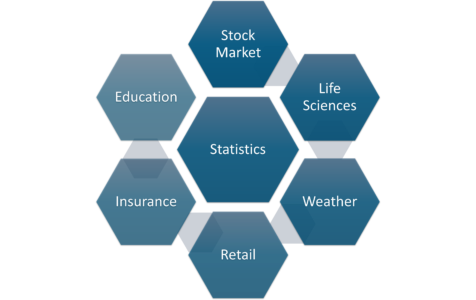
Statistics Applications – Math And Statistics For Data Science – Edureka
The field of Statistics has an influence over all domains of life, the Stock market, life sciences, weather, retail, insurance and education are but to name a few.
Moving ahead. let’s discuss the basic terminologies in Statistics.
One should be aware of a few key statistical terminologies while dealing with Statistics for Data Science. I’ve discussed these terminologies below:
Before we move any further and discuss the categories of Statistics, let’s look at the types of analysis.
An analysis of any event can be done in one of two ways:

Types Of Analysis – Math And Statistics For Data Science – Edureka
For example, if I want a purchase a coffee from Starbucks, it is available in Short, Tall and Grande. This is an example of Qualitative Analysis. But if a store sells 70 regular coffees a week, it is Quantitative Analysis because we have a number representing the coffees sold per week.
Although the purpose of both these analyses is to provide results, Quantitative analysis provides a clearer picture hence making it crucial in analytics.
Categories In Statistics
There are two main categories in Statistics, namely:
Descriptive Statistics helps organize data and focuses on the characteristics of data providing parameters.
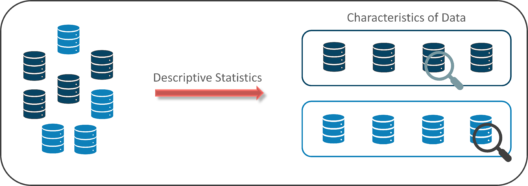
Descriptive Statistics – Math And Statistics For Data Science – Edureka
Suppose you want to study the average height of students in a classroom, in descriptive statistics you would record the heights of all students in the class and then you would find out the maximum, minimum and average height of the class.

Descriptive Statistics Example – Math And Statistics For Data Science – Edureka
Inferential statistics generalizes a large data set and applies probability to arrive at a conclusion. It allows you to infer parameters of the population based on sample stats and build models on it.

Inferential Statistics – Math And Statistics For Data Science – Edureka
So, if we consider the same example of finding the average height of students in a class, in Inferential Statistics, you will take a sample set of the class, which is basically a few people from the entire class. You already have had grouped the class into tall, average and short. In this method, you basically build a statistical model and expand it for the entire population in the class.
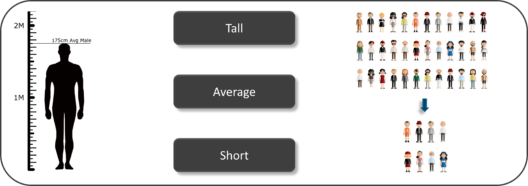
Inferential Statistics Example – Math And Statistics For Data Science – Edureka
Now let’s focus our attention on Descriptive Statistics and see how it can be used to solve analytical problems.
When we try to represent data in the form of graphs, like histograms, line plots, etc. the data is represented based on some kind of central tendency. Central tendency measures like, mean, median, or measures of the spread, etc are used for statistical analysis. To better understand Statistics lets discuss the different measures in Statistics with the help of an example.

Cars Data Set – Math And Statistics For Data Science – Edureka
Here is a sample data set of cars containing the variables:
Before we move any further, let’s define the main Measures of the Center or Measures of Central tendency.
Using descriptive Analysis, you can analyse each of the variables in the sample data set for mean, standard deviation, minimum and maximum.
Mean = (110+110+93+96+90+110+110+110)/8 = 103.625
The mpg for 8 cars: 21,21,21.3,22.8,23,23,23,23
Median = (22.8+23 )/2 = 22.9
Just like the measure of center, we also have measures of the spread, which comprises of the following measures:
Now that we’ve seen the stats and math behind Descriptive analysis, let’s try to work it out in R.
If you want to learn more about the R language, you can check out this video recorded by our R programming specialists.
This R Tutorial will help you understand the fundamentals of R.
There are n number of reasons why the world is moving to R. A couple of them are enlisted below:
If you’re still not convinced about why you must use R, the Statistical language, give this R Tutorial blog a read.
Now let’s move ahead and implement Descriptive Statistics in R.
It’s always best to perform practical implementation to better understand a concept. In this section, we’ll be executing a small demo that will show you how to calculate the Mean, Median, Mode, Variance, Standard Deviation and how to study the variables by plotting a histogram. This is quite a simple demo but it also forms the foundation that every Machine Learning algorithm is built upon.
Step 1: Import data for computation
>set.seed(1) #Generate random numbers and store it in a variable called data >data = runif(20,1,10)
Step 2: Calculate Mean for the data
#Calculate Mean >mean = mean(data) >print(mean) [1] 5.996504
Step 3: Calculate the Median for the data
#Calculate Median >median = median(data) >print(median) [1] 6.408853
Step 4: Calculate Mode for the data
#Create a function for calculating Mode
>mode <- function(x) { >ux <- unique(x) >ux[which.max(tabulate(match(x, ux)))]
}
>result <- mode(data) >print(data)
[1] 3.389578 4.349115 6.155680 9.173870 2.815137 9.085507 9.502077 6.947180 6.662026
[10] 1.556076 2.853771 2.589011 7.183206 4.456933 7.928573 5.479293 7.458567 9.927155
[19] 4.420317 7.997007
>cat("mode= {}", result)
mode= {} 3.389578
Step 5: Calculate Variance & Std Deviation for the data
#Calculate Variance and std Deviation >variance = var(data) >standardDeviation = sqrt(var(data)) >print(standardDeviation) [1] 2.575061
Step 6: Plot a Histogram
#Plot Histogram >hist(data, bins=10, range= c(0,10), edgecolor='black')
The Histogram is used to display the frequency of data points:
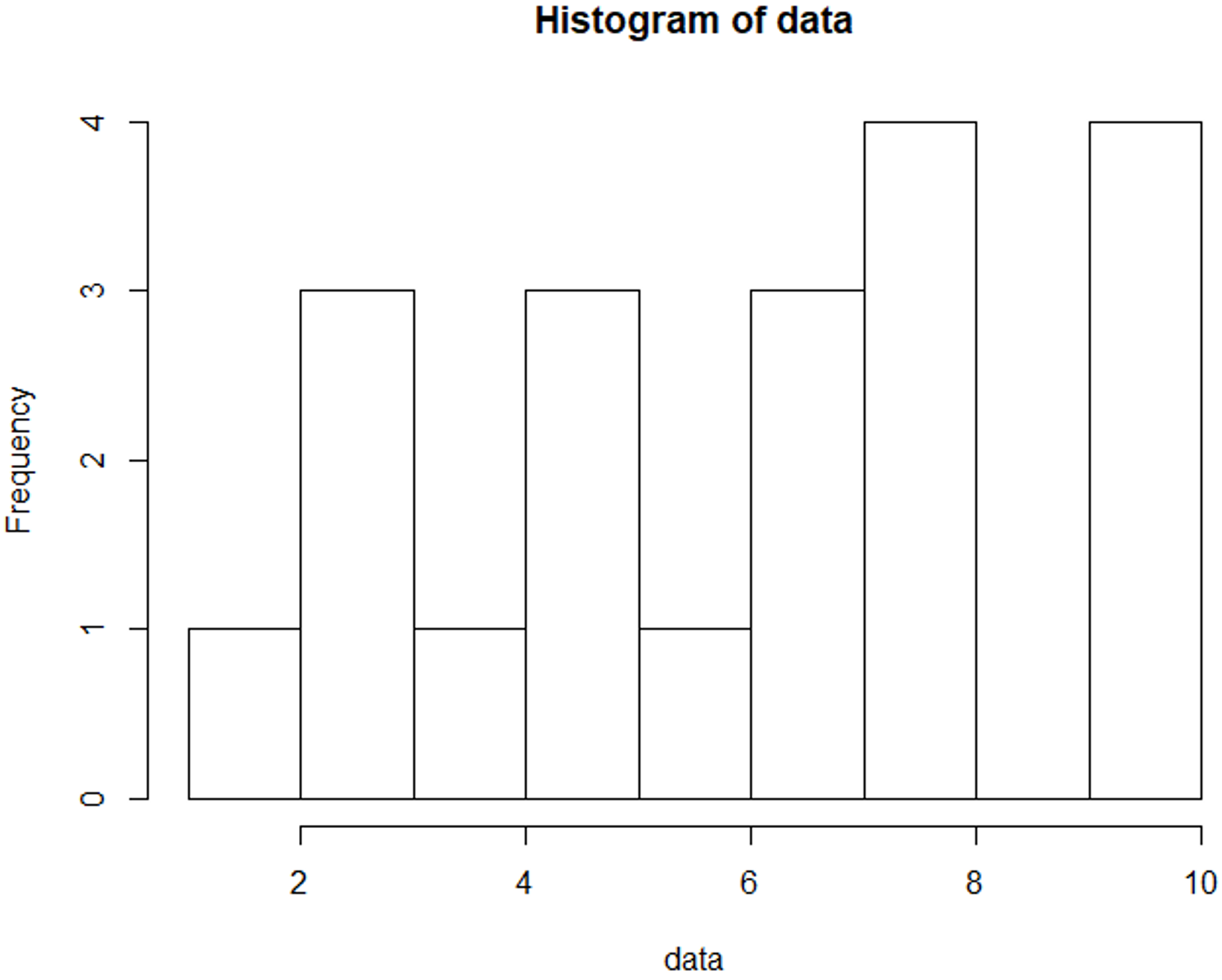
Math and Statistics For Data Science – Histogram – Edureka
So far, you’ve learned about Descriptive statistics, now let’s talk a little bit about Inferential Statistics.
Statisticians use hypothesis testing to formally check whether the hypothesis is accepted or rejected. Hypothesis testing is an Inferential Statistical technique used to determine whether there is enough evidence in a data sample to infer that a certain condition holds true for an entire population.
To under the characteristics of a general population, we take a random sample and analyze the properties of the sample. We test whether or not the identified conclusion represents the population accurately and finally we interpret their results. Whether or not to accept the hypothesis depends upon the percentage value that we get from the hypothesis.
To better understand this, let’s look at an example.
Consider four boys, Nick, John, Bob and Harry who were caught bunking a class. They were asked to stay back at school and clean their classroom as a punishment.

Inferential Analysis – Math And Statistics For Data Science – Edureka
So, John decided that the four of them would take turns to clean their classroom. He came up with a plan of writing each of their names on chits and putting them in a bowl. Every day they had to pick up a name from the bowl and that person must clean the class.
Now it has been three days and everybody’s name has come up, except John’s! Assuming that this event is completely random and free of bias, what is the probability of John not cheating?
Let’s begin by calculating the probability of John not being picked for a day:
P(John not picked for a day) = 3/4 = 75%
The probability here is 75%, which is fairly high. Now, if John is not picked for three days in a row, the probability drops down to 42%
P(John not picked for 3 days) = 3/4 ×3/4× 3/4 = 0.42 (approx)
Now, let’s consider a situation where John is not picked for 12 days in a row! The probability drops down to 3.2%. Thus, the probability of John cheating becomes fairly high.
P(John not picked for 12 days) = (3/4) ^12 = 0.032 <?.??
In order for statisticians to come to a conclusion, they define what is known as a threshold value. Considering the above situation, if the threshold value is set to 5%, it would indicate that, if the probability lies below 5%, then John is cheating his way out of detention. But if the probability is above the threshold value, then John is just lucky, and his name isn’t getting picked.
The probability and hypothesis testing give rise to two important concepts, namely:
Therefore, in our example, if the probability of an event occurring is less than 5%, then it is a biased event, hence it approves the alternate hypothesis.
In this demo, we’ll be using the gapminder data set to perform hypothesis testing. The gapminder data set contains a list of 142 countries, with their respective values for life expectancy, GDP per capita, and population, every five years, from 1952 to 2007.
We’ll begin by downloading the gapminder package and loading it into our R environment:
#Install and Load gapminder package
install.packages("gapminder")
library(gapminder)
data("gapminder")
Now, let’s take a look at our data set by using the View() function in R:
#Display gapminder dataset View(gapminder)
Here’s a quick look at our data set:

gapminder Data Set – Math And Statistics For Data Science – Edureka
The next step is to load the infamous dplyr package provided by R. We’re specifically looking to use the pipe (%>%) operator in the dplyr package. For those of you who don’t know what the pipe operator does, it basically allows you to pipe your data from the left-hand side into the data at the right-hand side of the pipe. It’s quite self-explanatory.
#Install and Load dplyr package
install.packages("dplyr")
library(dplyr)
Our next step is to compare the life expectancy of two places (Ireland and South Africa) and perform the t-test to check if the comparison follows a Null Hypothesis or an Alternate Hypothesis.
#Comparing the variance in life expectancy in South Africa & Ireland df1 <-gapminder %>% select(country, lifeExp) %>% filter(country == "South Africa" | country =="Ireland")
So, after you apply the t-test to the data frame (df1), and compare the life expectancy, you can see the below results:
#Perform t-test t.test(data = df1, lifeExp ~ country) Welch Two Sample t-test data: lifeExp by country t = 10.067, df = 19.109, p-value = 4.466e-09 alternative hypothesis: true difference in means is not equal to 0 95 percent confidence interval: 15.07022 22.97794 sample estimates: mean in group Ireland mean in group South Africa 73.01725 53.99317
Notice the mean in group Ireland and in South Africa, you can see that life expectancy almost differs by a scale of 20. Now we need to check if this difference in the value of life expectancy in South Africa and Ireland is actually valid and not just by pure chance. For this reason, the t-test is carried out.
Pay special attention to the p-value also known as the probability value. p-value is a very important measurement when it comes to ensuring the significance of a model. A model is said to be statistically significant only when the p-value is less than the pre-determined statistical significance level, which is ideally 0.05. As you can see from the output, the p value is 4.466e-09 which is an extremely small value.
In the summary of the model, notice another important parameter called the t-value. A larger t-value suggests that the alternate hypothesis is true and that the difference in life expectancy is not equal to zero by pure luck. Hence in our case, the null hypothesis is disapproved.
To conclude the demo, we’ll be plotting a graph for each continent, such that the graph shows how the life expectancy for each continent varies with the respective GDP per capita for that continent.
#Plotting a gdpPercap vs lifeExp graph for each continent
#Install and Load ggplot2 package
install.packages("ggplot2")
library(ggplot2)
gapminder%>%
filter(gdpPercap &lt; 50000) %>%
ggplot(aes(x=log(gdpPercap), y=lifeExp, col=continent, size=pop))+
geom_point(alpha=0.3)+
geom_smooth(method = lm)+
facet_wrap(~continent)
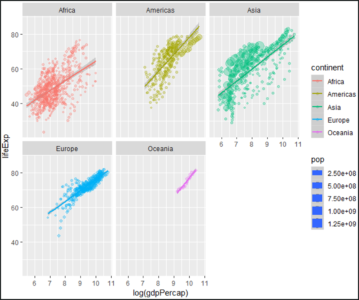
Plot – Math And Statistics For Data Science – Edureka
In the above illustration, you can almost see a linear variance in the life expectancy for each continent with respect to the GDP per capita. This also shows how well the R language can be used for Statistical Analysis.
Now that you know the Stats behind Data Science, I’m sure you’re curious to learn more about Data Science and Machine Learning. Here’s a list of blogs that you can refer after this:
With this, we come to the end of this blog. If you have any queries regarding this topic, please leave a comment below and we’ll get back to you.
Stay tuned for more blogs on trending technologies.
Innovative AI technology, instant language understanding with ChatGPT training course online.
If you are looking for online structured training in Data Science, Edureka! has a specially curated Data Science Course masters program that helps you gain expertise in Statistics, Data Wrangling, Exploratory Data Analysis, Machine Learning Algorithms like K-Means Clustering, Decision Trees, Random Forest, Naive Bayes. You’ll learn the concepts of Time Series, Text Mining, and an introduction to Deep Learning as well. New batches for this course are starting soon!!
Also, If you are looking for online structured training in Data Science, edureka! has a specially curated Data Science PG Program that helps you gain expertise in Statistics, Data Wrangling, Exploratory Data Analysis, and Machine Learning Algorithms like K-Means Clustering, Decision Trees, Random Forest, and Naive Bayes. You’ll learn the concepts of Time Series, Text Mining, and an introduction to Deep Learning as well. New batches for this course are starting soon!!
 Thank you for registering Join Edureka Meetup community for 100+ Free Webinars each month JOIN MEETUP GROUP
Thank you for registering Join Edureka Meetup community for 100+ Free Webinars each month JOIN MEETUP GROUPedureka.co